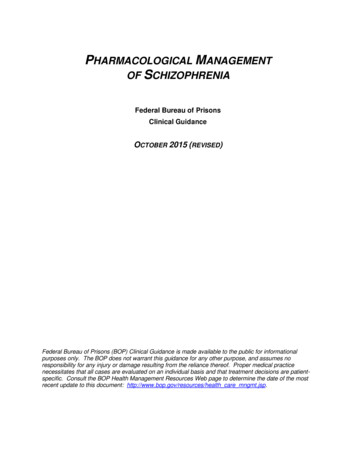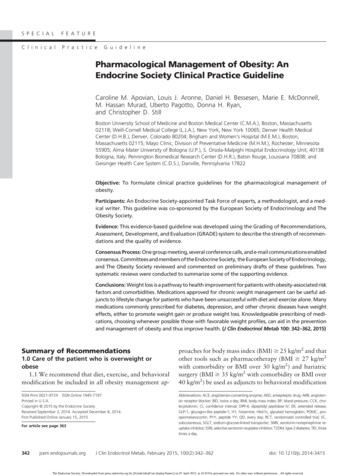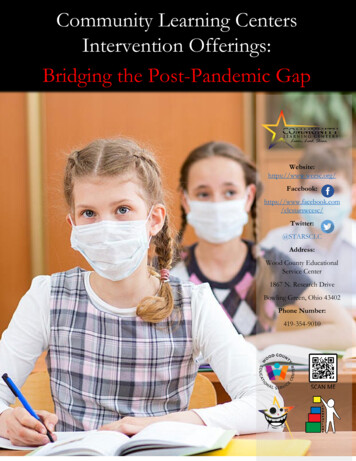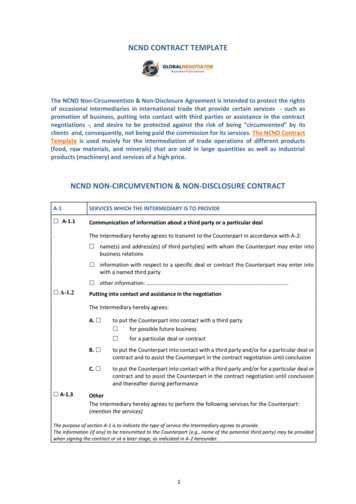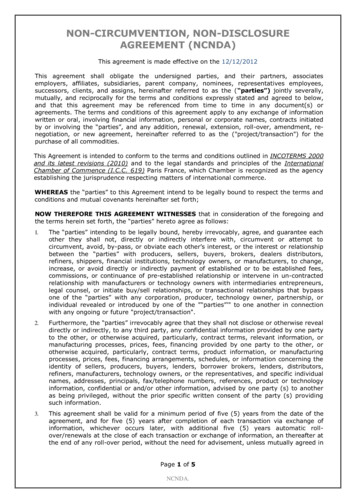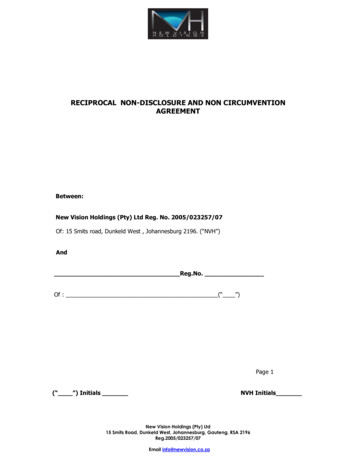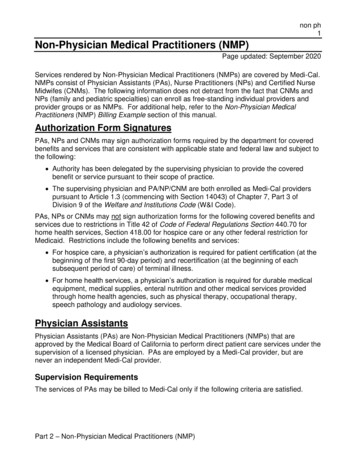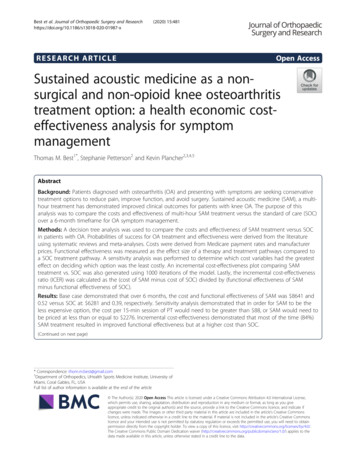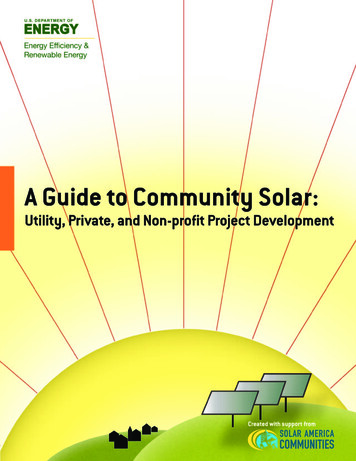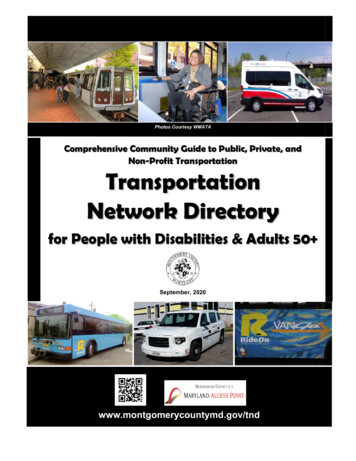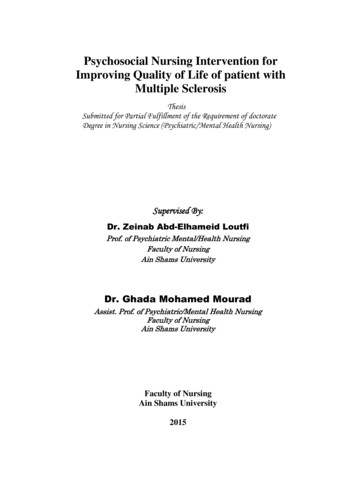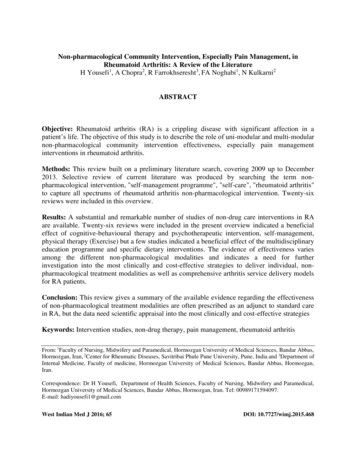
Transcription
Non-pharmacological Community Intervention, Especially Pain Management, inRheumatoid Arthritis: A Review of the LiteratureH Yousefi1, A Chopra2, R Farrokhseresht3, FA Noghabi1, N Kulkarni2ABSTRACTObjective: Rheumatoid arthritis (RA) is a crippling disease with significant affection in apatient’s life. The objective of this study is to describe the role of uni-modular and multi-modularnon-pharmacological community intervention effectiveness, especially pain managementinterventions in rheumatoid arthritis.Methods: This review built on a preliminary literature search, covering 2009 up to December2013. Selective review of current literature was produced by searching the term nonpharmacological intervention, "self-management programme", "self-care", "rheumatoid arthritis"to capture all spectrums of rheumatoid arthritis non-pharmacological intervention. Twenty-sixreviews were included in this overview.Results: A substantial and remarkable number of studies of non-drug care interventions in RAare available. Twenty-six reviews were included in the present overview indicated a beneficialeffect of cognitive-behavioural therapy and psychotherapeutic intervention, self-management,physical therapy (Exercise) but a few studies indicated a beneficial effect of the multidisciplinaryeducation programme and specific dietary interventions. The evidence of effectiveness variesamong the different non-pharmacological modalities and indicates a need for furtherinvestigation into the most clinically and cost-effective strategies to deliver individual, nonpharmacological treatment modalities as well as comprehensive arthritis service delivery modelsfor RA patients.Conclusion: This review gives a summary of the available evidence regarding the effectivenessof non-pharmacological treatment modalities are often prescribed as an adjunct to standard carein RA, but the data need scientific appraisal into the most clinically and cost-effective strategiesKeywords: Intervention studies, non-drug therapy, pain management, rheumatoid arthritisFrom: 1Faculty of Nursing, Midwifery and Paramedical, Hormozgan University of Medical Sciences, Bandar Abbas,Hormozgan, Iran, 2Center for Rheumatic Diseases, Savitribai Phule Pune University, Pune, India and 3Department ofInternal Medicine, Faculty of medicine, Hormozgan University of Medical Sciences, Bandar Abbas, Hormozgan,Iran.Correspondence: Dr H Yousefi, Department of Health Sciences, Faculty of Nursing, Midwifery and Paramedical,Hormozgan University of Medical Sciences, Bandar Abbas, Hormozgan, Iran. Tel: 00989171594097.E-mail: hadiyousefi1@gmail.comWest Indian Med J 2016; 65DOI: 10.7727/wimj.2015.468
Non-pharmacological Community Intervention in Rheumatoid ArthritisINTRODUCTIONThe spectrum and severity of rheumatoid arthritis (RA) is not very different in developing anddeveloped countries, the dismal rheumatology services in developing countries furthercompounds the burden (1). The incidence and prevalence of these conditions, it has been proved,is dynamic, not static, and appears to be influenced by both genetic and environmental factors(2). Ample information has been collected in the community oriented programme for control ofrheumatic disease (COPCORD) studies (3) to show wide prevalence of RA. The prevalence ofclinical RA recently reported by the WHO ILAR COPCORD urban and rural surveys in Indiavaried from 0.45 to 0.68% (4) in Iran was noted as urban 0.33% and rural 0.19% (5, 6) in AsiaPacific countries was calculated 0.33% (7) and in developed populations 0.5% to 1% of the adultpopulation (8).Despite substantial advances in medical treatment, RA is a disease that continues to affectthe lives of individuals considerably (9, 10). The challenge is to find a cost-effective treatmentfor better disease control (11, 12). Pharmacological treatment has recently seen great advances,but is associated with increased toxicity and cost also the long term outcome is still unknown.Non-pharmacological treatment is cheap, less toxicity better long term outcome (4, 9, 10, 13).The objective of this literature review is to present the most recent evidence related to thenon-pharmacological intervention programme for management of the rheumatoid arthritis toinform the development of evidence based recommendations for general practitioners working inthe healthcare setting.2
Yousefi et alMATERIAL AND METHODSThis review is built on a preliminary literature search. The literature review was conducted inJuly 2010 up to 2014. Articles published from 1990 to 2013 were considered. The literaturereview was raised by a thorough search conducted in MEDLINE, Pub MED (Pub MED Centraland pub MED Heath), EMBASE, Web of Science and the Cochrane Library were searched toidentify studies for inclusion.The following search strategies were adapted to apply to the other databases. Using aMESH term of "rheumatoid arthritis", "arthritis", "rheumatic diseases", "Joint", "complementarytherapies", "non-prescription drugs", "intervention studies", "self-care", "pain management" tocapture all spectrums of rheumatoidarthritisnon-pharmacologicalintervention and self-management practices, inclusion was limited to English language publications. The final searchstrategy sought to identify non-pharmacological intervention studies of all levels of evidence.Concurrently a manual search was carried out to find an article review of reference lists ofretrieved papers. In the beginning, the papers were selected for inclusion based on the title andabstract. Studies providing evidence on the efficacy of an intervention or compared to anotherintervention were included. Initial searches failed to identify many articles related to nonpharmacological intervention programme for management of the rheumatoid arthritis.Participants of interest to this literature review were people aged 16 years or over with adiagnosis of RA. The review focussed on data in adult populations (above 16 years of age).Intervention in the form of any non-pharmacological intervention used to manage RA waseligible for inclusion. Articles focussing on non-pharmacological interventions in RA, with a3
Non-pharmacological Community Intervention in Rheumatoid Arthritiscommunity approach, big sample size, with control, randomize control trial (RCT) and having acore measure of pain VAS were selected. Other alternative treatments controversy has arisenover the employment of therapies same occupational therapy, podiatry, hydrotherapy, jointprotection, ultrasound, acupuncture, laser therapy, use of compression gloves, thermotherapy,use of splints or orthoses, homeopathy and transcutaneous electrical nerve stimulation (TENS)which were not being eligible for inclusion.The search strategy was formulated by Ovid in cooperation with a medical librarian tomake it applicable to all the databases. A computerized broad search strategy was developed.Retrieved hits were assessed by three of the authors (HY, FA, NK), who screened the titles andabstracts to identify relevant studies. If there was doubt about a study’s relevance, one of theexpert authors (AC) was consulted. The relevant full-text article was read by three authors(AC, HY, RF). The methodological quality of included review was independently assessed bytwo reviewers (AC, HY). Data was extracted by two of the authors (HY, NK). If doubt occurred,one of the other authors (AC) was consulted. In the search finding following statement was usedto indicate direction of reduced pain effect.RESULTSThe literature search identified 14 362 references, which were first examined on the basis oftitles and abstracts. Of these, 13 963 references were not related to the non-pharmacologicalintervention programme for management of the rheumatoid arthritis diseases. Two hundred and4
Yousefi et alsixty-one references were not RCT study. One hundred and thirty-eight references were retrievedin full text. One hundred and twelve reviews were excluded: 49 because of conducted to mixrheumatic and musculoskeletal disease and 41 were conducted by other than rheumatoid arthritis.19 because of no relevant intervention on pain. Three because of duplicate publication. Twentysix reviews were included in this overview (Fig. 1).Potentially relevantreviews identified andscreened for retrievaln 14 362Reviews clearly not relevant tothe non-pharmacologicalintervention programme in RAn 13 963Reviews clearly not RCTstudyn 261Reviews retrieved in full textn 138112 Reviews were excluded:Mixed rheumatic and musculoskeletaldisease (n 49).Conducted with others than rheumatoidarthritis (n 41).No relevant intervention on pain.(n 19).Duplicate publication (n 3).Reviews with useable information byoutcome were included in thisoverview (n 26)Fig: 1. Selection process of eligibility reviews from all identified citations.5
Non-pharmacological Community Intervention in Rheumatoid ArthritisCognitive-behavioural therapy and psychotherapeutic interventionA hospital based on six month studies by Sharp et al, designed and conducted to examine the efficacy of CBT (Fig. 2) onpreventing psychological and physical morbidity in patients with RA.Fig: 2. Uni-modular and multi-modular self-management programmeCBT: Included 8 individual sessions each of 1hour per week, developed from standard pain management approaches and selfhelp educational material developed for patients with arthritis. The programme included an educational component plus theself-management skills of relaxation training, attention diversion, goal setting, pacing, problem-solving, cognitive restructuring,assertiveness and communication, and management of flare-ups or high-risk situations [14].LMAP: Included two modules, each with four meetings of 2.5 hours duration and one 2-hours review meeting (onerheumatology OT, one community OT and one rheumatology PT delivered modules). Participants could attend two LMAPmodules and review meeting over a 3- to 9-month period as convenient to them. Module 1 was developed from a behaviouraljoint protection programme. The concepts discussed in meeting 1 were RA, health beliefs, personal impact of arthritis,understanding the multiple factors affecting symptoms, attitudes, personal experiences, self-management methods andmotivating for change. Meetings 2–4 focussed on ergonomic approaches to reduce pain, exercises, fatigue management and thebenefits of splints. Module 2, focussed on participants’ exercise beliefs, barriers and problem-solving. Cognitive symptommanagement included stress management and coping, pain management, distraction and relaxation practice. The reviewmeeting included progress with goals, drug therapy, investigations, communicating with health professionals, teamcare andtopics of participants’ choice (eg diet, complementary therapies, work support services, Social Security Benefits). Participantworkbooks were provided for each module with key points, illustrations and diaries to record practicing joint protection, pacingand exercise [15].GESO: The programme consisted of 5 weekly 2-hour group sessions for 8 patients, with or without a significant other. Theprogramme included 3 booster sessions of 2 hours each after 3, 6, and 9 months. Each group had 2 trained leaders (during the 2days of training): a specialized arthritis nurse and a nurse with experience in working with RA patients. Patients received aprogramme book with information on the sessions, a self-help guide, various brochures on RA, and an audiotape withrelaxation exercises. The programme included the contracting, goal setting, self-management and problem solving, Informationon RA and treatment, Pain management and relaxation, physical exercises, coping with depression. In the booster sessions, theaccomplishments of goals and problems during the past 3 months were discussed and feedback was given. The assessmentswere done before, immediately after and 6 and 12 months after intervention [18].MSCG: In the programme patients, who participated in 10 sessions, supported by a manual for patients and led by 2supervisors. All sessions lasted 2 hours. The first 8 sessions were weekly sessions, the 9th session was 2 weeks after the 8thsession, and the 10th session was 3 weeks after the 9t h session. At the end of every session (except for the very first session),homework assignments were given. In the CIG, the programme was teaching patients action-directed coping and coping byseeking social support; 4 steps of problem-solving steps: 1) describe the problem; 2) think about all kinds of possible solutions;3) choose 1 or more solutions; 4) implement the solution or solutions and evaluate the results. In the MSCG programme topics6
Yousefi et alof conversation for all sessions were determined by the patients during the first session to exchange information, experiences,feelings, and emotions of the participants. The sessions were led by 2 patients who were trained in supervising mutual supportgroups [19].In-patient treatment consisted of a fixed period of 11 days, each session weekly, performed by the physical therapist,occupational therapist and social worker, which prescribed regimens of bed rest and a daily individual range of motion, musclestrengthening exercise programme, joint protection, self-care, household and work activities, joint splints, adaptive equipmentand coping with the disease. During out-patient care, the prescription of drugs, paramedical treatment and splints was left to theattending physician to the out-patient clinic [21, 22]. The training programme was scheduled for nine sessions within 2 weeks,each group consisted of eight patients, and encompassed a multidisciplinary cooperation between rheumatologists, orthopedists,physiotherapists, psychologists, and social workers. The following fields were covered: mechanisms of RA, drug therapy,physiotherapy, practical exercise, relieving pain and muscle tension, joint protection devices, joint replacement, copingstrategies, stress management and relaxation ex
interventions in rheumatoid arthritis. Methods: This review built on a preliminary literature search, covering 2009 up to December 2013. Selective review of current literature was produced by searching the term non- pharmacological intervention, "self-management programme", "self-care", "rheumatoid arthritis" to capture all spectrums of rheumatoid arthritis non-pharmacological intervention .

